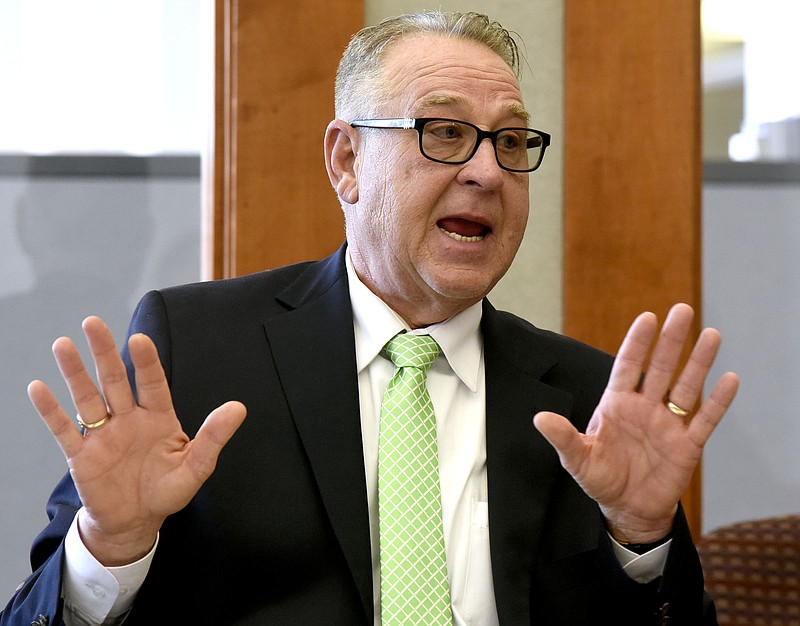One of the most vexing infrastructure issues involving Hamilton County in many years appears nowhere near being solved.
Indeed, as the can keeps being kicked down the road, it becomes more and more evident that no one entity or individual has all the facts needed to make a good decision, that the politics behind the decision-making process are murky at best, and that additional uncovered facts about how to best resolve sewage treatment issues only serve to complicate whatever decision eventually will be made.
The issue is a dirty one - what to do about sewage in the northeast part of the county.
Last fall, both the Regional Planning Commission and Hamilton County commissioners voted down a resolution that would have authorized a new sewage treatment plant at a Mahan Gap Road site near Ooltewah.
And last week, a citizens search committee commissioned by Hamilton County Mayor Jim Coppinger to find a new sewage treatment plant site recommended, instead, that all sewage flow continue to be sent to the city's Moccasin Bend Wastewater Treatment Facility.
Complicating the problem is a coming consent decree involving the Hamilton County Water and Wastewater Treatment Authority (WWTA) and the federal Environmental Protection Agency. But some officials have said one has nothing to do with the other - that whatever ongoing maintenance issues the WWTA will be forced to resolve through the decree do not affect how sewage is to be handled in any new development in that end of the county.
Coppinger, in making his pitch for a de facto sales tax rise in September 2017, made a new sewage treatment plant one of the three legs in his argument (the need for a new jail and school construction being the other two).
When the original county landfill site was deemed unacceptable for the plant, a new site was selected by the WWTA - from many others - and said to be the cheapest to build on and operate, and best from a geographical standpoint. However, area homeowners cried foul, saying not enough due diligence was done on the site and communications on the issue was lacking.
Coppinger, since, has acknowledged those concerns.
It's been suggested that announcing that the consent decree was coming in early 2019 made the rush to the proposed site on Mahan Gap Road - in the words of one Hamilton County commissioner - a "time sensitive crisis."
That seemed especially true since, after commissioners voted down the selected site, the consent decree would, it was said, be finalized in late summer or early fall of this year.
Meanwhile, others in the Northeast Hamilton County area have suggested inertia in making a decision is not such a bad thing. After all, homes in the area are being built with septic tanks, as they have been for decades, and a bill is currently on its way to Tennessee Gov. Bill Lee that would allow the state to provide septic tank permits where a sewer moratorium is in place but property requirements are met.
In addition, Coppinger's citizens committee produced a document that showed the northeast part of the county, which a new sewage treatment plant would serve, is expected to have the smallest (2 percent) real estate demand over the next 10 years of any other sector in the county.
"Growth should follow infrastructure, not infrastructure follow growth," committee chairman Dean Moorhouse said. "There's more supply than demand in North Hamilton County."
And while the committee recommended sending sewage to Moccasin Bend, it made three North Hamilton County sites its third through fifth choices. An East Ridge location was the committee's second choice.
Yet, from its extensive analysis, and despite having to work around what members said was a lack of cooperation from the WWTA, the committee strongly believed in its No. 1 choice.
"It's a win-win situation," said Moorhouse. "It's an opportunity for the city and the county to work together."
He also said former WWTA Executive Director Jim Harrison acknowledged at one point that using Moccasin Bend would offer sewage capacity for the northeastern part of the county for 40 years.
"We like our No. 1 pick because we don't like something [like a sewage treatment plant] we don't have control over," said citizens committee member Brent Smith. "We don't want other people to go through that. We truly believe Moccasin Bend has future capacity and a future growth plan. Why not invest the money [for a plant] in teachers and firemen?"
The week before last, before the citizens panel made its recommendation, Chattanooga City Councilman Chip Henderson asked that a resolution be prepared seeking a cost/benefit analysis on a consolidation of the city sewer program with the WWTA. And on Wednesday, having received the citizen panel's recommendation, Coppinger authorized a resolution allowing members of the commission to discuss consolidation of wastewater treatment with members of the city council.
Those discussions and a cost/benefit analysis of a consolidation are small steps toward what currently seems the safest and smartest route to go. But the variables are so many, and a solution still appears far away. But maybe the first real steps toward progress have been taken.
